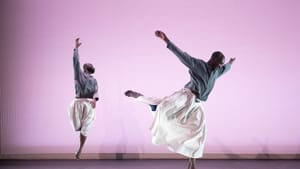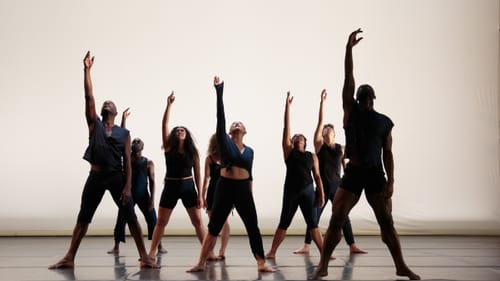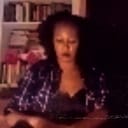Stay in the Loop
BSR publishes on a weekly schedule, with an email newsletter every Wednesday and Thursday morning. There’s no paywall, and subscribing is always free.
Stirring things up with Shakers
Philly Fringe 2024: Fist and Heel presents POWER

Reggie Wilson’s New York-based performance troupe, Fist and Heel, provided an amazing Fringe dance experience through POWER. In 1858-59, Mother Rebecca Cox Jackson, a free Black woman based in Philadelphia, established and led a majority Black Shaker community that lasted 40 years. Wilson imagines what might have happened in her worship services through an incredibly explosive 50-minute show that demanded I watch, participate, and enjoy.
Embracing shaker influences
POWER was co-commissioned by New England dance school Jacob’s Pillow and Hancock Shaker Village, a living history museum. The historical dance research paid off as Shaker influences reverberated throughout the show. The set included a clean, empty stage, a wooden fixture with hooks, and a plain wooden bench. The choreography and music seamlessly intertwined African American spirituals, West African dance, modern dance, and Shaker dance configurations. There are certain parts people might mistakenly credit to African American culture by viewing the group clapping as call and response when it’s just crowd interaction. But there is a lot of overlap. Shakers embodied ecstatic dance through shaking body parts and creating concentric circles with stomping, clapping, and pointing feet. Their music involved speaking in tongues and mimicking the speech patterns of Native Americans and West Africans. (They also believed in sexual equality and technological innovation involving wood. No wonder POWER called back to Jackson.)
On-stage excellence
The choreography was deceptively simple yet incredibly complex—enough so that they hired Jesse Wolfson as a math advisor. The beauty occurred through the diverse uniformity, the line dance complexity, and the confluence of a cappella vocals with West African dance. Parts of the modern choreography were synchronized yet with deliberate one-beat delays. I loved the line dance that broke out into groups of twos and threes. There are moments later in the show where some of the performance appeared semi-improvised, but I wasn’t certain.
I loved the opening, where three dancers executed deep plies (reminiscent of Alvin Ailey’s seminal Wade in the Water choreography) while Wilson’s unaccompanied tenor-baritone vocals rang through the theater. In elementary school, my religious and music classes frequently analyzed Joseph Brackett’s "Simple Gifts," a Shaker song with a repeated chorus of “by turning, turning they come round right.” One of POWER’s ecstatic trance dancing pieces appeared reminiscent of Brackett’s “turning” phrase, Turkish Whirling Dervish culture, Middle Eastern Zar trance dancing, and African American tongue-induced spiritual trances. They straight up had church on stage through Annie Wang’s performance.
The costumes easily merged cultures and time periods through Shaker dresses made from West African Batik cloth, colonial waistcoats (reflecting the Shaker’s introduction to the states), and neutral overalls (reflecting slave culture, 19th-century dress style, and Shaker plain clothes).

Uniformity and community through diversity
Fist and Heel is a great example of cast uniformity through diversity and audience participation. I love that Fist and Heel includes a cast of different nationalities, races, ethnicities, heights, body sizes, and ages. I hated when, 10 years ago, newly-appointed artistic director Angel Corella reduced PA Ballet by 40 percent because certain dancers did not fit his height, body, or age ideals. My favorite dance instructors (now in their 50s to 70s) continue to perform and teach. I didn’t realize how I missed seeing taller or more seasoned dancers until POWER. Regardless of age and size, Wilson’s entire cast has serious strength and grace. I can’t help but recognize Bria Bacon’s numerous biceps upon triceps upon biceps, Paul Hamilton’s utterly delightful movements, and Michel Kouakou’s striking solo.
POWER also pulls from audience participation. Throughout the show, the audience remained silent until Reggie Wilson locked eyes with me—the only person clapping in the audience—and raised his hands to signal others to join in. The closing finale, which taught the audience Shaker hand movements, added to the utter joy of the performance. Participating in communal beauty can heighten the experience.
What, When, Where
POWER. By Reggie Wilson, presented by Fist and Heel Performance Group. $35. September 20-22, 2024 at FringeArts, 140 N Columbus Boulevard, Philadelphia. (215) 413-9006 or phillyfringe.org.
Accessibility
FringeArts Theater is a wheelchair-accessible venue with gender-neutral restrooms. Hearing assisted headsets are available. Complete accessibility information is available on the FringeArts website.
Sign up for our newsletter
All of the week's new articles, all in one place. Sign up for the free weekly BSR newsletters, and don't miss a conversation.

 An Nichols
An Nichols